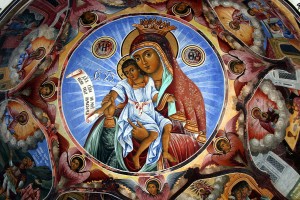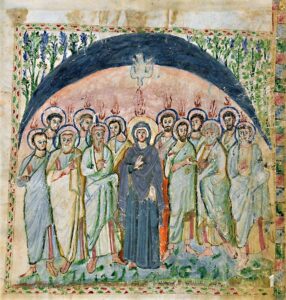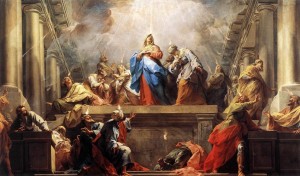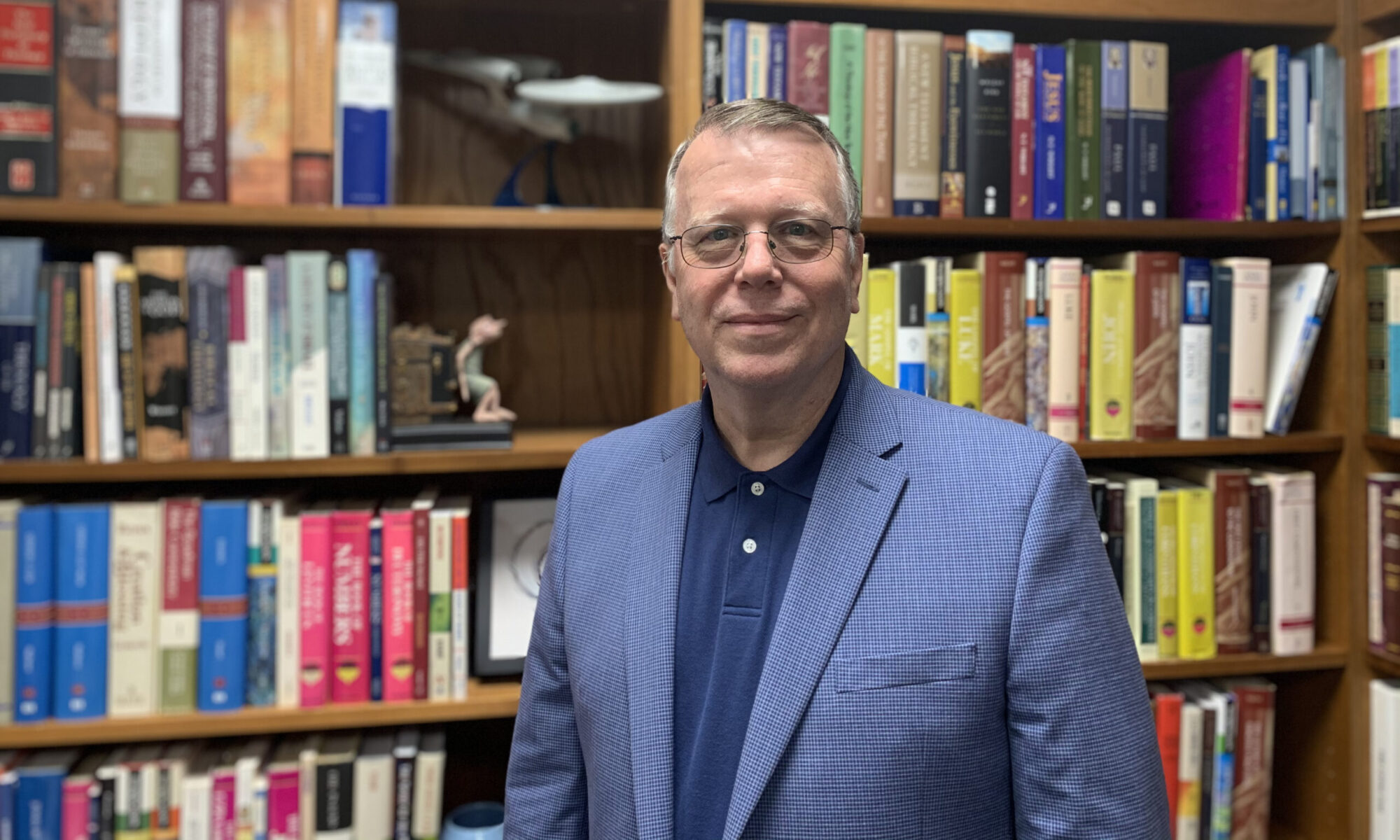I was scheduled to present this response to Father George Montague at the 2020 Society for Pentecostal Studies annual meeting. That meeting was canceled due to the coronavirus pandemic. It may be that we will present our papers at the 2021 annual meeting. I offer my response here. Father Montague’s paper may be available in other venues.
I must express my gratitude for being invited to respond to Father Montague. I have long benefited from his work, and the work of his co-laborer, Father Kilian McDonnell. I am not the most qualified respondent, but I share a passion for the Roman Catholic-Pentecostal Dialogue in general, and this subject in particular. I should also add that this is my Pentecostal response, not the Pentecostal response.
My first extra-biblical consideration of Mary came in a church history class in Bible college. The text for that class was Earle Cairns’ Christianity through the Centuries. Cairns attributed the development of Mariology to “the false interpretation of Scripture and the mass of miracles associated with Mary in the apocryphal gospels” (160). Of course, the insinuation was that any understanding of Mary in human redemption is heretical. Many years later at Pentecostal Theological Seminary (then Church of God Theological Seminary), when discussing the role of Mary in the Incarnation, our professor insisted that Mary should not be addressed as “Mother of God,” but as “Mother of Our Lord.”
My interest in Mary was born out of travels in eastern Europe in 1999. As I visited ancient Orthodox churches and monasteries I was overwhelmed at the beauty of the art, and by the ubiquity of Mary. She was everywhere, most often with the Christ-child sitting in her lap.

From my Western-Protestant-Pentecostal perspective, I could not understand why there were so many images of Mary and the Christ-child, but so few images of the crucified Christ, the resurrected Christ, or the ascended Christ. After returning home from my journey, I continued to ponder, “Why is the Virgin Mary so important to Orthodox (and Catholic) believers?” Then, one day I had an epiphany – it’s not about Mary, it’s about Jesus! It’s about the Incarnation. So, I revisited the development of Mary as theotokos. Does Pentecostal spirituality have room for Mary. I offer a resounding, “Yes”!
First, I found it interesting that nowhere in this paper does Father Montague refer to Mary as “Mother of God”, but as “the mother of the Lord”, which is reminiscent of my professor at PTS. So allow me to assert that Mary, the mother of the Lord, is theotokos – the Mother of God. Christotokos will not do. Sometimes, sloppy preaching in Pentecostal churches lends itself to various forms of modalism, Arianism, and Nestorianism. Pentecostals need to be reminded that Jesus is more than the “Anointed One”; Jesus is the enfleshed Word of God. In my judgement, only theotokos is faithful to Nicene Christology. Jesus, the son of Mary, is fully human and fully God. The eternal Word assumed humanity in the womb of Mary. As Father Montague points out, the womb of Mary was the Tabernacle of the glory of God the Son. The divine-human Christ was nurtured by the breasts of Mary. Mary is indeed the Mother of God.
Father Montague’s paper presents Luke’s infancy narrative as “a tapestry woven with threads of the Old Testament.” Father Montague’s weaving is the work of a master. I found this to be fascinating. With Father Montague, I affirm that the Biblical evidence suggests that Mary had “a key role in the divine initiative” of redemption. Mary is the “highly favored One”. This language is rarely heard in Pentecostal spirituality. Father Montague’s primary concern is to demonstrate how the Lukan narrative, informed by the Old Testament, inspires the Catholic theological imagination in regards to Mary. I will respond to three theological icons: (1) The Immaculate Conception, (2) The Assumption of Mary, and (3) Mary as the Queen of Heaven.
The Immaculate Conception. Father Montague suggests that the Lukan greeting, “Hail Mary, full of grace”, signifies “something completed, perfect, adorned with freely and superabundantly given grace”. Therefore, “the text refers to a perfection already attained” and “to the grace of a vocation to which she is now being called”. At its foundation, the issue at hand is not about Mary, but about the sinlessness of Jesus Christ. How is Jesus, conceived in the womb of a fallen woman, the sinless One? The Catholic answer is the doctrine of the Immaculate Conception of Mary in which “the first instance of her conception, by a singular grace and privilege granted by Almighty God… [Mary] was preserved free from all stain of original sin” through “the merits of Jesus Christ”. Montague points out that this doctrine was affirmed after “long hesitation” (Ineffabilis Deus, 1854) for fear of misunderstanding. I would suggest that the “long hesitation” did not diminish misunderstanding in the least.
Mary is not the only person in Scripture to be greeted and called out by an angel.
-
- An angel of the Lord called out to Abraham to spare Isaac from sacrifice (Genesis 22:11).
- To Hagar an angel declared, “Behold, you are with child, and you shall bear a son. You shall call his name Ishmael” (Genesis 16:11; cf. 7-12). Later, when Hagar feared the death of Ishmael, an angel said, “Fear not” (Genesis 21:17).
- To Gideon an angel declared, “The Lord is with you, you mighty man of valor” (Judges 6:12).
- To Manoah’s unnamed wife, the mother of Samson, an angel declared, ”you are barren and have borne no children, but you shall conceive and bear a son” (Judges 13:3).
- Gabriel greeted Daniel as “greatly beloved” (NKJV) or “highly esteemed” (NASB) (Daniel 9:23; 10:11).
Although Mary’s vocation is unique in Scripture, her angelic visitation is not. In most cases, the words of the angel signify an oracle of salvation and a call to vocation. But Mary is the only person in the redemptive narrative whose vocation is to offer her body as tabernacle of the glory of God’s Son. So, consideration of Mary’s uniquely favored status is warranted. Father Montague insists that Gabriel’s greeting “highly favored one” refers to a “perfection already attained” which implies that Mary was perfected prior to the Annunciation, even conceived in perfection. I concede that Gabriel’s greeting signifies Mary’s predisposition to be utterly faithful to the call of God; but I disagree that it signifies an immaculate conception, a sinless birth. That Mary was fallen, herself in need of redemption, is explicit in the Immaculate Conception which is effected through the merits of Christ.
Is there an alternative to the doctrine of Immaculate Conception? How might the divine-human Christ be born of a fallen woman and not inherit original sin? I suggest that Gabriel’s Spirit-inspired greeting, “Rejoice, highly favored one, the Lord is with you; blessed are you among women!” (Luke 1:28 NKJV), was a prophetic declaration that effected Mary’s unique sanctification. The same Holy Spirit who overshadowed the womb of Mary, also sanctified her in a unique manner, imparting to her the righteous of God. I’m suggesting that the answer to the problem of Mary’s original sin is not a better developed Mariology, but a better developed pneumatology. Catholics have sometimes tended to lose the Spirit in discussions of church organization, liturgy, or Marian devotion. Protestant theology has sometimes been, more or less, binitarian (Father and Son), losing the Spirit in conversations about soteriology. Pentecostal spirituality insists on maintaining the personal (hypostatic) distinction of the Holy Spirit. Even so, with our Catholic sisters and brothers, Pentecostals should affirm that Mary is the uniquely elect One, highly favored, and therefore holds a special status in God’s redemptive plan.
The Assumption of Mary. Montague holds that the assumption of Mary is “a most logical consequence” of the election of Mary as mother of the messiah-king who participates “in the glorification of her son”. He admits that “Mary’s assumption and coronation as Queen of Heaven is nowhere explicitly recorded in the New Testament”.
Here we discover a major rift between Pentecostals and Catholics, that is, the nature of revealed truth. Montague insists that the Assumption of Mary is revealed in centuries-old Church tradition. Pentecostals maintain that Holy Scripture is the primary source of revealed truth. Both traditions insist that the Holy Spirit speaks through the community of faith. In Roman Catholic spirituality, Scripture and tradition are equal sources of revealed truth. However, in Pentecostalism every prophetic utterance and every interpretation of tongues must be judged by the rule of Scripture. Therefore, as a Pentecostal, it is difficult to imagine that a major doctrine would find acceptance among the faithful without strong biblical support.
Ultimately, I find the Assumption of Mary to be unnecessary to Nicene Christology. Remember, theotokos was born out of Christological concerns. If Mary is indeed the Queen of Heaven who acts as intercessor, then a robust understanding of resurrection is sufficient. All who die in Christ are resurrected and glorified. I have no doubt that Mary is alive in heaven, in intimate fellowship with her Son, the Lord Jesus Christ.
Mary as the Queen of Heaven. If my Pentecostal understanding on the role of Scripture in informing the theological imagination is to be followed, then this deserves serious consideration. Please allow me a word of caution. When discussing my work, Pentecostal Sacraments: Encountering God at the Altar (2010, 2019), I have often been told that my view is too Catholic. My response has been, “I’m not concerned if it’s too Catholic, my primary concerns are that it’s biblical, and faithful to Pentecostal spirituality.” Too often, conversations among Pentecostals suffer from anti-Catholic bigotry. So, the challenge here is to put aside preconceived notions and engage in a respectful and serious conversation.
According to Father Montague, the Davidic queen mother, “always subordinate” to the king “occupied a throne at the right side of her son” as “an honored counselor” with “great moral influence” who sometimes “instructs the king on how to rule” and “had the right to seek favors of the King”. Montague sees “a significant advance” of the queen mother motif in Luke. Montague presents this as the biblical rationale that informs Mary’s work as co-redemptrix, a term not used by Montague, but implied, and affirmed by St. John Paul II (Redemptoris Mater, 1987). In effect, St. John Paul suggested that Mary acts as co-mediator in a way that does not diminish the work of Christ as the “one Mediator” (1 Timothy 2:5). I find this tenuous. The prefix “co” signifies mutuality, commonality, and coequality. This has the tendency to deify Mary (not in the sense of theosis), to view Mary as the “Mediatrix of all Graces,” even as mediator of the Holy Spirit. Several years ago I was watching EWTN, listening to a group of Catholic women testify about being filled with the Holy Spirit. One of the women declared, “I felt as if I stepped into Mother Mary.” From my Pentecostal perspective, a theology that diminishes the unique status of Christ as the “only mediator between God and man”, and as the Spirit-baptizer, is problematic. While it is likely that the queen mother motif is in the background of the Lukan infancy narrative, and further informs the uniquely favored status of Mary, I cannot find biblical justification for Mary as Queen Mother of Heaven who acts as co-redemptrix.
Even so, there is sufficient biblical evidence to suggest that Mary has a unique and significant role in God’s story of human redemption, a role that has too long been ignored by Pentecostals. Does Mary uniquely mediate grace? Yes! Through her obedience to the Father, the eternal Word was enfleshed in her womb, and she gave birth to Jesus who is “full of grace and truth” (John 1:14). Jesus Christ is the uniquely-begotten Son of God, the King of kings; therefore, the Virgin Mary is the unique-begatter, the Mother of God, the Queen Mother – theotokos.
Does Mary, as theotokos, occupy a unique status as Queen Mother, offering intercession on behalf of her petitioners? Does she offer counsel to the omnipotent and omniscient Lord? Should Mary be petitioned and venerated? I believe that Mary is alive and in fellowship with her Son, and with the great cloud of witnesses in heavenly places. Jesus declared that God “is not the God of the dead but of the living” (Matthew 22:32; Mark 12:27; Luke 20:37). Abraham, Isaac, and Jacob are alive. Moses and Elijah are alive. Peter and Paul are alive. St. John Paul is alive. My grandparents are alive. My niece is alive. All who have died in Christ are raised in Christ. I believe in the intercession of the saints, that the great cloud of resurrected witnesses are praying for God’s kingdom to come, for God’s will to be done on earth as it is in heaven. I believe that Mary, as theotokos, is unique among the cloud of witnesses and that she has a unique relationship with Christ, even as Queen Mother. However, there is no biblical text to support that believers should offer prayers to Mary, or seek her intercession. Pentecostal spirituality insists upon an unmediated encounter with God. Trinitarianism has room only for the Father, Son, and Holy Spirit as co-equal partners in human redemption. Only Jesus and the Spirit are co-equal mediators and advocates for human redemption.
There can be little doubt that Mary, the mother of Jesus, was a major presence in the life of the apostolic church. Luke’s gospel begins with the Annunciation, when the Archangel Gabriel declared Mary to be highly favored and full of grace. The Virgin Mary gave birth to Jesus Christ. She was with Jesus at the marriage in Cana of Galilee, and she was seen with Jesus throughout his ministry. Mary was with Jesus as he died on the cross. She was a witness to the resurrected Christ, and she was present on the day of Pentecost. As we read the early theologians, we discover that there was indeed some reflection on the role of Mary in the redemptive story. Ireneaus writes that just as Christ is the New Adam, Mary is the New Eve (Against Heresies, 3.22.4). Furthermore, he declares that “as the human race fell into bondage to death by means of a virgin, so is it rescued by a virgin” (Against Heresies 5.19.1).
The earliest images of Pentecost place Mary in the center which reflects her growing influence in the theological imagination of the church.

Father Montague’s paper reminds us that reflection on the significance of Mary did not begin with Irenaeus, but with Luke (and Matthew). Her story is essential to the Gospel. Joel (and Peter) declared that the Spirit of God would be poured out upon all flesh and sons and daughters would prophesy. Luke suggests the outpouring of the Spirit began with the Annunciation, when the Holy Spirit came upon and overshadowed Mary. The fruit of her womb is Jesus, the Holy Spirit baptizer, the only mediator between God and humanity.
My favorite image of Pentecost is the work of Jean Restout (1732). Mary is in the center, with the followers of Jesus in the Upper Room. The Spirit is poured out. Mary is a recipient of the Spirit, not a mediator of the Spirit. But there she is, highly favored, and full of grace – the First Lady of Pentecost.

